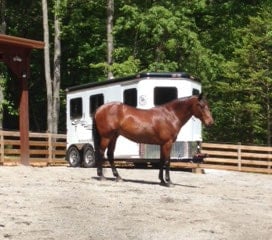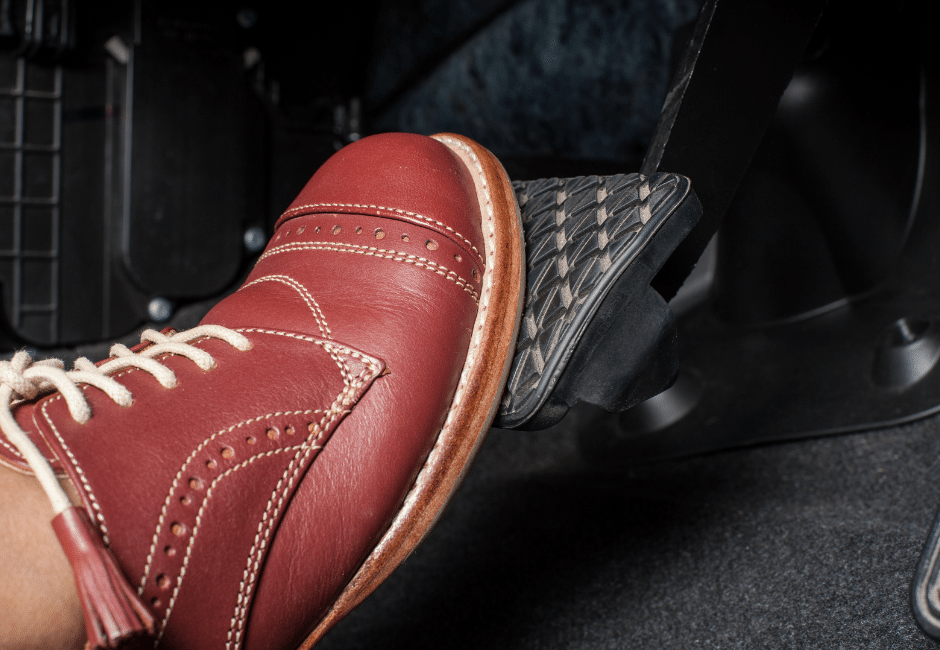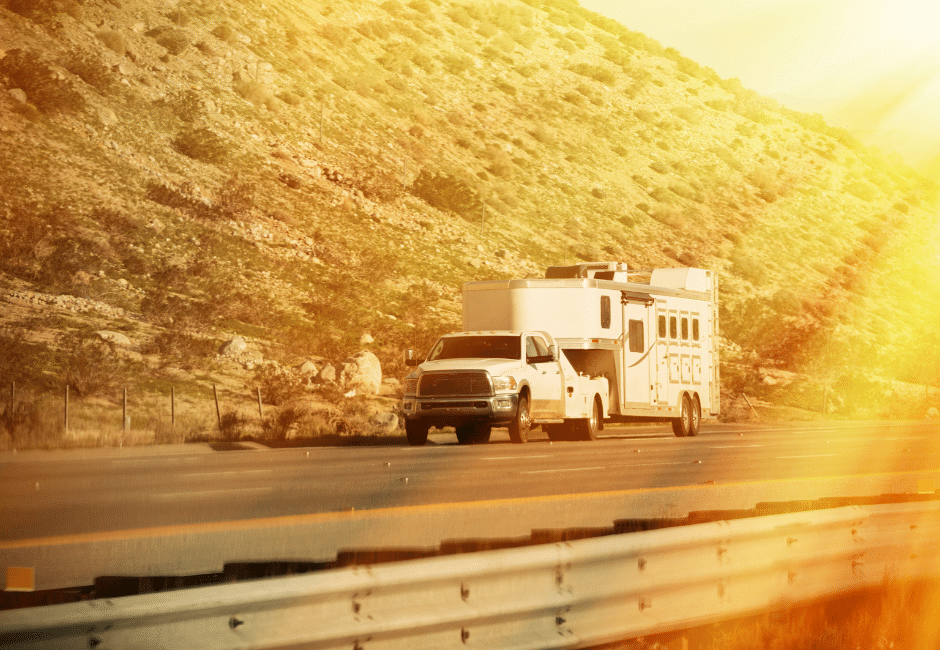Five Things Horse Owners Wish that Other Drivers Knew
 There is a lot to learn when buying a horse trailer, whether it is a regular trailer or a one with living quarters. It’s a lot of work - and stress - to find and buy that trailer, but the adventure really begins once you get that new trailer onto the road.
There is a lot to learn when buying a horse trailer, whether it is a regular trailer or a one with living quarters. It’s a lot of work - and stress - to find and buy that trailer, but the adventure really begins once you get that new trailer onto the road.
Drivers who have never pulled a horse trailer quickly realize that they can’t drive like they did before with a car. Combine that with other drivers on the road oblivious to the fact you’re towing a live animal, and this becomes a stressful activity.
If this is your first time pulling a horse trailer, there are some things you should know to make your life a little easier. If you’ve been traveling and hauling your trailer for a while now, we’re sure that you could probably throw in a story or two yourself about being on the road.
The point is this - whether you’re still shopping for a horse trailer for sale or are a veteran puller, you probably wish the other drivers on the road knew these five things about trucks with horse trailers in tow.
Good driving is not a question of luck, it’s skill and practice. Make sure YOU are doing everything you need to do to keep your horses, vehicles, and yourself safe while out there traveling.
Here are five things we wish all drivers would be aware of when we’re out there on the road with our trailers. Maybe a few of them will be new to you too!
In this article...
Precious cargo
There’s precious cargo in that trailer. Precious means dear, important, valuable, or irreplaceable. You may be transporting your own horse for trail riding, or it may be a racehorse in that trailer. They are all precious. But if other drivers realized that the horse in the trailer behind you meant as much to you as your child, they might be a little more cautious when passing and keep their distance while driving.
Too many people have never been around a live horse and think of them as possessions and not living creatures. How can you make them aware that your precious cargo is invaluable to you? Here are a few suggestions.
Know how to drive safely
This is the first thing to keep in mind. Practice driving, backing up, and turning with your trailer with an experienced driver, or take a driver’s education course. You won’t know everything but at least you’ll have practiced the basic manoeuvres under supervision.
Keep your rig and trailer in good shape
Our vehicles are an extension of ourselves. If you keep your vehicle and trailer clean and maintain the mechanics on a regular basis, it’s unlikely that your vehicle will be a nuisance on the road.
But we’ve all seen that driver towing a rig – horse trailer or otherwise – that is in poor repair. It’s not always the age that counts, but it is a factor. Defective equipment such as shock absorbers result in a lopsided weight distribution. This can make it more difficult for the driver to maintain speed or to manoeuvre correctly.
It is up to you to make sure your vehicle and trailer are in the best shape they can be. Not only will it reduce the chances that you’ll be stopped somewhere – either by law enforcement or due to mechanical damage – but it also means your horses will be safer as well.
Deceleration – or the distance you need to stop
You need lots of space to stop. Stopping a fully loaded trailer of any sort means it’s going to take some time. When you’re transporting live cargo, you must be aware of several factors.
Mass, force, time, and distance
A typical compact car that you’ll be on the road with weighs about 3,000 lb (about 1,400 kg) and has about 120 horsepower. It can accelerate to 65 mph (100 km/h) within about 650 feet (200 metres) in less than 10 seconds.
A pickup truck and horse trailer may weigh 17,600 lb (8,000 kg). Even though the truck may have a diesel engine producing over 300 horsepower, because of the weight of the combination and its load, it may take 1640 feet (500 metres) or more to accelerate to 65 mph (100 km/h) and take 30 seconds or more to do so.
Now think about stopping this combination from 65 mph (100 km/h) to zero. How much energy is needed to stop it? You’re certainly going to want to stop in a much shorter distance than that it took you to accelerate. In an emergency, you may have as little as SEVEN seconds to act — about one-quarter of the time it took you to reach 65 mph (100 km/h).
To stop the vehicle in one-quarter of the time it took to accelerate requires a stopping force of four times the acceleration force — the equivalent of approximately 1,200 horsepower.
The distance you need to come to a full stop is now the distance your vehicle and trailer - with your horse inside - will travel from the moment you:
• See the hazard
• The time it takes for your brain to realize you must stop (you are still moving)
• The action of placing your foot on the brake until you stop.

Then, you need the actual braking time, which is based on the speed you were travelling, and the conditions of your brakes and tires – brake linings or pads to produce the friction, the brake drums to dissipate heat, and the tires to grip the road.
You’ve only got five and a half seconds left. Let’s hope the brakes and tires will do their job because there’s no time left.
Anti-Lock Brakes
Contrary to what you might think, anti-lock braking systems (ABS) do not allow you to stop quicker. These types of brakes help prevent wheel lock-up on surfaces where conventional brakes usually lock up — including slippery surfaces such as those with water, ice, wet leaves, grease, or spilled fluids. This means you can brake hard without skidding and losing steering control. They may also help you prevent your vehicle from jackknifing.
Anti-lock brakes are only as good as the driver. Learn the correct technique and practice it so that you are ready in an emergency.
The five-second rule
When driving behind others with your horse trailer, always respect the “five-second” rule. In other words, pick a landmark that the vehicle in front of you is passing, then count five seconds. If you cross the landmark in less than five seconds behind them, slow down and increase the distance between you.
Water
Water that gets into the brake drums will reduce their braking efficiency. Avoid driving through large amounts of water whenever possible.
If you must drive through water on the roadway - and let’s face it, we all do - apply the brake pedal with your foot as you approach the water. Placing a slight drag, or slight constant pressure on the brakes while you drive through the water will reduce the amount of water entering the brake drums and shoes.
Once you’re out of the water, apply a slight pressure on the brake pedal for a short distance to dry out the brakes.
Inertia
Your horse is not attached to the trailer, even if he is tied to a hook. Understand the first law of motion – a body in motion remains in motion unless acted upon by some outside force. This means that if you’re traveling at 65 mph, and you stop, your horse’s mass will continue to move in the same direction you were traveling. Unless he encounters the trailer wall, it will take some time for him to flex his muscles and stabilize his weight to counterbalance this force. Therefore, it is so important to slow down gradually - not only do you need the space to slow all that weight’s momentum, but you also want to do it gently enough to prevent injuries from falls.
If your trailer suffers a collision, it’s likely that your horse will hit the trailer wall at the same speed you were doing before the collision. Remember, a body in motion stays in motion unless…
This can be an extremely traumatic ending to a great adventure.
Acceleration
A truck hauling a trailer makes for slow acceleration. Just like stopping takes time, so does starting up again.
You’re going to do whatever you need to prevent accidents inside your trailer, and slow starts are just as good for helping horses keep their balance as slow stops. Impatient drivers can’t make you go any faster by crowding you in traffic and often create more dangerous driving conditions.
Stay Zen!
As we said earlier, it may take 1640 feet (500 metres) or more to accelerate to 65 mph (100 km/h) and take 30 seconds or more to do so. There are 5,280 feet in a mile, so that distance is the equivalent to ONE-THIRD of a mile.
Keep your cool and let others pass you. Remain as polite as you can, even when others are not.
Travelling on hills
You will undoubtedly encounter hills on your journey. What goes up, will go down.
Uphill

Downhill
Almost all brake failures and downhill runaway crashes are caused by overdriving the ability of the brakes to deal with heat — in other words — poor speed control. Go down the hill at a speed below the speed of other traffic to avoid overdriving your brakes.
Again – there are people who won’t be too happy with you, including some semi-trucks who like to gather speed going downhill to save fuel if the hill goes up on the other side.
Turning
Wide turns are the only kind trailers make. Horse trailers aren’t sports cars built with tight turn radiuses - they need space to turn, and the longer the trailer, the more space it takes. You don’t want to invade other lanes or accidentally curb your trailer, so you’re going to take your time in those wide turns, too. You’re just being careful - it’s not a conspiracy to annoy the guy behind you in the silver Honda.
Be careful out there
If you’re currently looking at buying a horse trailer, there are lots of upgrade features that can help you provide the smoothest ride for your equine cargo, but even the best trailer on the market still requires a careful driver. If only the other drivers on the road would give you a little more space and try to put themselves in your shoes, trailering would be a lot safer for everyone on the highway.
We know that travelling with a trailer - and live horses inside of it - can be stressful. Stay courteous and avoid confrontation. For example, don’t block traffic (in the wrong lane) with your vehicle and trailer. If you’re travelling slower than other traffic, such as when going uphill, change lanes or pull over where safe to let other drivers pass.
Rule of thumb: when you get behind the wheel of your vehicle, and you’ve got your horse (or horses) in a trailer behind you, take a minute, take a deep breath, and slow down. Remaining as calm as possible should be your new mantra because you will have your patience tested while driving and your emotions can impair your ability to drive safely. Investigators have found that the causes of some crashes are directly linked to emotional disturbances that distracted drivers and prevented them from focusing on their driving.
Safe driving always demands your full attention.
Next time you’re out puttering around and come upon a truck with a trailer in tow, remember what they’re going through - and get out of the way. Maybe give them a wave - or at least a smile - as you go by. Courteous is as courteous does, and the proverb “Do unto others as you would have them do unto you” has never been more appropriate.
Safe travels!

